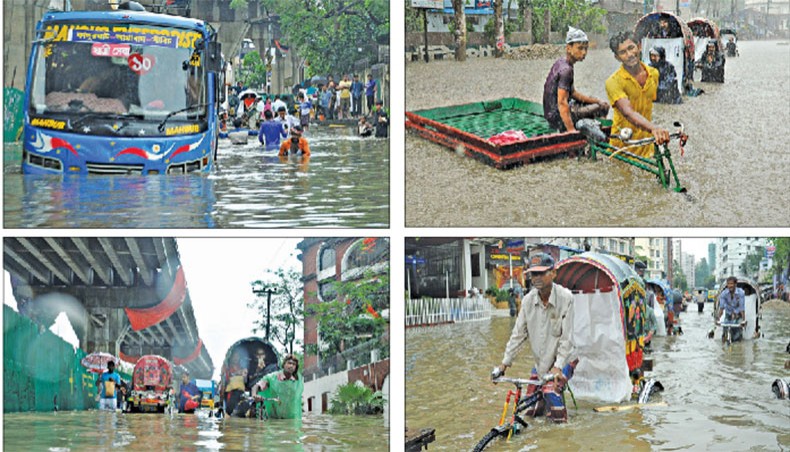Rain wreaks havoc in Ctg
Downpour combined with high tide on Friday sent low-lying areas of Chittagong city under water, bringing normal life almost to a halt.
Filthy water overflowing the drainage system flooded houses, shops and other business establishments, leaving people to do their daily works in knee to waist-deep water.
People living in the ground floor in the water-logged areas were forced to hole up on their bed and relocate their furniture and valuables while many moved to their relative’s residence far away.
Many CNG-run auto-rickshaws, cars and human haulers got stuck on the road after they went out of order. Commuters in different areas faced difficulty for the shortage of public transport.
Only a few rickshaws that plied the roads made brisk business by charging three to four times than the usual fare.
Stagnant water on the road caused a lot of sufferings to the people who went to say their jumma prayers.
Heavy rain in between 6:00am to 3:00pm, combined with high tide in the River Karnaphuli, left Muradpur, Bahaddar Hat, Bakalia, Chwak Bazar, Gate number two, Sholshahar, GEC intersection, WASA intersection, Lalkhan Bazar, Agrabad, Halishahar and Badurtola in the city under water.
Patenga Met office in Chittagong recorded 78.4 mm of rainfall from 6:00am to 3:00pm, said Waresunnabi, senior observer of the office.
He said that heavy rain accompanied by temporary gusty wind was likely to occur in Chittagong till April 24.
Met office officials said that high tide aggravated water-stagnation.
Canal and drains usually flow water into the Karnaphuli but when a high tide hits an area, the flow of these canals and drain is blocked, resulting in stagnation of water, which causes a flood-like situation.
Chittagong city mayor AJM Nasiruddin also blamed high tide for the water-stagnation in the low-lying areas.
‘We are taking up new plan for re-excavation of canals to get rid of this problem,’ he said.
Jasim Uddin Chowdhury, a businessman, said he was stuck at Muradpur intersection for around two hours from 9:00am as his CNG auto-rickshaw could not cross the area through waist-deep water.
Rahman Ali, a shopkeeper of West Bakalia, was found removing water which entered into his grocery shop to save sugar, flour and rice from getting wet.
Women, elderly people and children were the worst sufferers because of the water stagnation.
Jebunnahar, a housewife of Chwakbazar, said water entered her house and damaged all the belongings, including TV, refrigerator, beds and furniture.
She said ground floors of all the buildings in the area were inundated.
City planners have been blaming absence of coastal embankment, regular cleaning of drains, construction of new drains, re-excavation of canals and punitive measures against encroachment for the water-stagnation in the port city.
As a result of hill cutting, the soil is washed down with rain water and fills drains and nearby water bodies and causes water-stagnation.
Moreover, all kinds of solid wastes — domestic, industrial and medical — make this situation even worse and cause severe water-stagnation in the city, they say.
Water-stagnation in the low-lying areas is a decade-old problem for Chittagong, said urban planner Subash Barua.
He suggested that construction of new drains, re-excavation of canals and dredging in the Karnaphuli could solve the problem.
A holistic plan and its execution by the city corporation, Chittagong WASA, Chittagong Development Authority was must to change the situation, he observed.
- See more at: http://www.newagebd.net/article/14015/rain-wreaks-havoc-in-ctg#sthash.WcU2yLmt.dpuf











